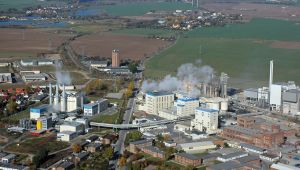Soda for the entire world comes from Staßfurt

Sodawerk Staßfurt looks back on an eventful time – and serves as an example of one of the many successful business stories in Saxony-Anhalt. In its 130-year history, the factory located near the state capital of Magdeburg has survived two world wars, the Great Depression and a structural adjustment process after the reunification of Germany. The successful privatisation after the fall of the Berlin Wall was followed by investments and the introduction of modern production processes. A subsidiary of the Polish Ciech Group, Staßfurt has become a modern chemical plant and one of the largest employers in the region.
Visitors on a tour of Sodawerk Staßfurt are surprised at first. There are many halls, tracks and steaming plants but very few staff. But appearances can be deceptive. 400 employees work in shifts at the factory. Everything is rotated, everything is in flux here.
Soda production from Staßfurt rock salt has a 130-year tradition. The factory is one of the oldest companies in the region and was founded in 1892 in order to use the local rock salt and limestone deposits for the production of soda. After the end of the Second World War, the Soviet occupying power dismantled large parts of the production plant. The remaining factory was nationalised in 1953 and merged with the Bernburg soda factory in 1965 to form the state-owned Vereinigte Sodawerke Bernburg-Staßfurt.
The Belgian Solvay group kept back its old plant in Bernburg in 1991. However, the production site in Staßfurt faced an uncertain future directly after German reunification. A Danish investor initially bought the company. A financing company joined in 1995 and a Frankfurt investment company took over in 2007. In the same year, the Polish Ciech Group acquired the plant in Staßfurt. Together with the Ciech soda capacities, Sodawerk Staßfurt immediately became the second largest producer of soda products in Europe.
Why invest in the global corporation in Saxony-Anhalt? The availability of raw material, the logistically convenient location and the modern organisation of the capacities made the plant a strategic partner of choice for Ciech.
The German-Polish cooperation is also a step towards a flourishing trade partnership that connects the neighbouring countries. Germany is the largest investment location for Polish companies, with Saxony-Anhalt at the forefront.
The company's history in Staßfurt is rewritten from now on. Just after one year after the Polish partners joined, a new production facility was brought into operation for the production of heavy soda. The Ciech Group brought a lot of experience to the traditional company. With the location in Staßfurt, the company operates four soda plants in Poland, Romania and Germany. As a local supplier, the plant has been supplying all major flat glass manufacturers in Saxony-Anhalt for many years.
The commercial director and management spokesman, Grzegorz Zalewski, leads the fate of the factory together with his two colleagues Holger Zutz and Piotr Glowicki, who are responsible for production and technology. With their products, they are an important partner across Germany for all glass container manufacturers, for detergent, animal feed and chemical industries as well as for flue gas cleaning. The strategy for the plant can be simply summed up: "The group's strategy is associated with the local experience value."
That seems to be working. After many years of economic ups and downs, soda from Staßfurt is once again in demand internationally as well as in the region. The main customers are large glassworks in Haldensleben, Osterweddingen and Gardelegen in Saxony-Anhalt. The soda plant in Staßfurt has an annual production capacity of more than 560,000 tons in Germany with a market share of nearly 30 percent. A major advantage of the location is that the factory can rely on its own raw material reserves. The two essential raw materials of salt and limestone are mined in close proximity to the production facilities. The availability and quality of the raw materials can thereby be secured over the long term.
These raw materials are now used in a variety of ways as never before in the history of the company. In addition to the main product of heavy soda, light soda and sodium carbonate (which is also known as baking soda) are produced in Staßfurt.
The main use is as clear as glass: 20 percent of soda, sand, limestone and aggregates are melted down for glassmaking. The chemical industry also requires soda to extract chemicals such as alkaline phosphates, chromates or ultramarine. Sodium carbonate is used in many chemical processes to regulate the pH value, especially when a slow reaction process is desired. It is therefore no wonder that soda from Staßfurt is in demand.
Author: Manuela Bock on behalf of IMG – Investment and Marketing Corporation Saxony-Anhalt
Contact:
An der Löderburger Bahn 4a
39418 Staßfurt
Telefon: +49 39 25 26 30
+49 39 25 62 30 39
E-Mail: info@sodawerk.de
www.ciechgroup.com
